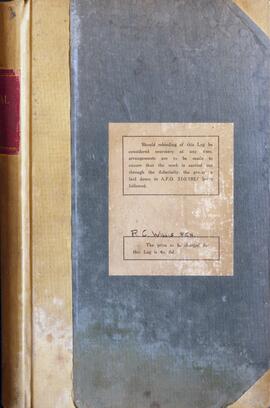Title and statement of responsibility area
Title proper
General material designation
- Textual record
Parallel title
Other title information
Title statements of responsibility
Title notes
Level of description
Repository
Reference code
Edition area
Edition statement
Edition statement of responsibility
Class of material specific details area
Statement of scale (cartographic)
Statement of projection (cartographic)
Statement of coordinates (cartographic)
Statement of scale (architectural)
Issuing jurisdiction and denomination (philatelic)
Dates of creation area
Date(s)
-
1939-12-01 - 1941-03-01 (Creation)
- Creator
- Willis, Robert Clifford
Physical description area
Physical description
1 discrete item
Publisher's series area
Title proper of publisher's series
Parallel titles of publisher's series
Other title information of publisher's series
Statement of responsibility relating to publisher's series
Numbering within publisher's series
Note on publisher's series
Archival description area
Name of creator
Biographical history
Custodial history
Scope and content
Midshipman Robert Clifford Willis was a Royal Canadian Navy officer, As a Midshipman he was holding the most junior rank of a naval officer, an officer by courtesy but not yet commissioned. His logbook contains a handwritten account and pictures of the battle of the Mediterranean, including the sinking of the Italian battleship, the Bartolomeo Colleoni.
During the Battle of Calabria, Midshipman Willis was on board the HMS Royal Sovereign. He also wrote in his Journal about the British Navy's attack on neutral French Navy ships stationed at the Mers El Kébir naval base near Oran, on the coast of French Algeria. The attack was part of Operation Catapult, a British plan to prevent neutral French ships from falling into German hands after the Allied defeat in the Battle of France. The British bombardment of the base resulted in the death of 1,297 French servicemen, the sinking of a battleship, and the damaging of five other ships. In contrast, the British suffered a loss of five aircraft and two crewmen. The Royal Navy carried out the attack by air and sea after France had signed armistices with Germany and Italy, which came into effect on 25 June.
The British were particularly concerned about the five battleships of the Bretagne and Richelieu classes and the two fast battleships of the Dunkerque class, which were the second largest force of capital ships in Europe after the Royal Navy. The British War Cabinet was worried about these ships falling into Axis hands. Despite repeated assurances from Admiral François Darlan, the commander of the French Navy, that the fleet would remain under French control, even after the French armistices with Germany and Italy, Winston Churchill and the War Cabinet deemed the risk too great. Darlan refused British requests to place the fleet in British custody or move it to the French West Indies, out of German reach. Midshipman Willis was on board for HMS Royal Sovereign and HMS Malaya and was part of other Operations which he recorded in his Journal
Midshipman Willis had a long career with the Royal Canadian Navy. Records show that he was a Paymaster Midshipman during World War II in 1940 and a Paymaster Lt. at Cornwallis in 1943/44. He was also found attending the University of Western Ontario in 1959 and was the Commander of the Naval Supply Depot in Halifax in 1965.
Notes area
Physical condition
Journal is in fair condtion
Immediate source of acquisition
Arrangement
Language of material
- English
Script of material
Location of originals
The original document is stored in the archive of the Shearwater Aviation Museum
Availability of other formats
A photocopy is available.
Restrictions on access
Open to researchers without restriction
Terms governing use, reproduction, and publication
Please note that materials cannot be borrowed and must be used within the confines of the archive's special collections room.
Finding aids
Associated materials
Accruals
No further accruals are expected
Alternative identifier(s)
Standard number
Standard number
Access points
Subject access points
Place access points
Name access points
- Midshipman Robert Clifford Willis RCN (Subject)

